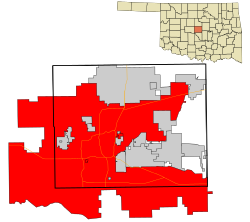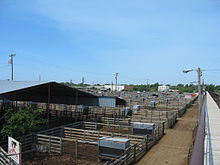Oklahoma City
| Oklahoma City | |
|---|---|
| Nickname : OKC | |
 Downtown Oklahoma City skyline, 2012 |
|
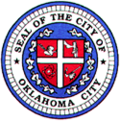 seal |
 flag |
| Location in Oklahoma | |
| Basic data | |
| Foundation : | July 15, 1890 |
| State : | United States |
| State : | Oklahoma |
| Counties : |
Oklahoma County Cleveland County Canadian County Pottawatomie County |
| Coordinates : | 35 ° 28 ′ N , 97 ° 31 ′ W |
| Time zone : | Central ( UTC − 6 / −5 ) |
|
Inhabitants : - Metropolitan Area : |
638,367 (as of 2016) 1,373,211 (as of 2016) |
| Population density : | 406.4 inhabitants per km 2 |
| Area : | 1,608.8 km 2 (approx. 621 mi 2 ) of which 1,570.6 km 2 (approx. 606 mi 2 ) are land |
| Height : | 396 m |
| Postcodes : | 73101-73199 |
| Area code : | +1 405 |
| FIPS : | 40-55000 |
| GNIS ID : | 1102140 |
| Website : | www.okc.gov |
| Mayor : | Mick Cornett (R) |
Oklahoma City is the capital of the US state Oklahoma and its economic and cultural center. The city is the county seat of the Oklahoma County of the same name . It is one of the largest cities on the Great Plains and is located on the North Canadian River in the center of the state of Oklahoma. According to official estimates, it had around 640,000 inhabitants in 2016, making it the most populous city in Oklahoma. Around 1.37 million people lived in the metropolitan region in 2016.
From 1954 to 1956, the KWTV transmission mast, the tallest structure in the world, was located in Oklahoma City.
The city was the site of a bomb attack in April 1995 in which 168 people were killed. It was the worst terrorist attack in United States history prior to the September 11, 2001 terrorist attacks .
history
During the 19th century, Indian tribes from across the country were forcibly displaced into Indian territory by the American central government . The area of what is now Oklahoma City was considered Unassigned Lands because it was not assigned to a tribe. In February 1887 a railroad depot named Oklahoma Station was opened in this , before the infrastructure was expanded with the construction of a post office in December of the same year.
On April 22, 1889, what is now Oklahoma City was settled by over 10,000 Anglo-Americans as part of the Oklahoma Land Run . A provisional government was installed a few days after the Land Run . Oklahoma City was formally incorporated on July 15, 1890, about two months after the Oklahoma Territory was established. This was followed by the first elections, from which William J. Gault emerged as the winner. On August 12, 1890, he became the first mayor of the city who did not hold this office provisionally.
Initially, Oklahoma City served as the seat of County Two and Guthrie as the territory's capital. Up until membership in the United States in 1907, Oklahoma City tried to displace the previous capital as the economic center of the new state. A petition proposed Oklahoma City as the new capital, and an election held on June 11, 1910, emerged victorious.
The population doubled over the course of the first ten years. Even after that, the new town grew steadily until oil was discovered in the area on December 4, 1928 . The “black gold” was pumped out of the earth everywhere . Oil was even extracted on the lawn of the Capitol. The influence of oil money accelerated growth. Oklahoma City became an attractive Victorian city with access to the rail network and industrial development. The population grew to 64,000.
While many made big bucks in oil, the majority of Americans were not fortunate enough to escape the Great Depression . By 1935, Hooverville was built on the south bank of the North Canadian River, named after Herbert C. Hoover , a shanty town built by rural emigrants and the unemployed. The river was often flooded and brought disease and destruction to the people who lived there. As part of the so-called New Deal , first experience in public housing was gained and the water level of the river was lowered through measures by the Works Progress Administration and Civilian Conservation Corp , which later became a problem for the city, as the river had hardly any water in some years . Also in 1935, the first parking meter invented by Carl Magee was installed in the city .
In the 1970s, the city experienced a boom thanks to the oil boom and the construction of a car factory by the General Motors concern. In the 1980s, the bankruptcy of Penn Square Bank (1982) and the collapse in oil prices in the middle of the decade caused a major economic crisis. Many houses in the center of the city were empty; there was only one hotel in the center. Unemployment was around 10 percent. The recession lasted into the 1990s.
On December 14, 1993, the citizens voted for the MAPS (Metropolitan Area Projects) project, which provided for a temporary tax increase. With the additional income, the city financed investments in the infrastructure without having to take on debt. Among other things, a library, a canal and a sports arena were built. The plan to make the city more attractive for potential employees in this way, in order to attract companies as a result, worked. Today the project is considered a success and is jointly responsible for the positive development of economy and culture, which is reflected in the construction of hotels and museums.
Most of the city's banks reacted to the crisis of the 1980s and from then on adhered to a conservative, less risky lending policy . This fact explains why the city was only slightly affected by the global economic crisis from 2007 onwards .
On May 20, 2013, the city was hit by the bog tornado . The result was severe damage to buildings and 24 deaths.
Bomb attack
On April 19, 1995, the Alfred P. Murrah Federal Building was the target of the Oklahoma City Bombing , which killed 168 people and injured over 800. On the morning of April 19, a van loaded with about three tons of explosives detonated on 5th Street in front of the building. A third of the building was blown away.
During the search for the perpetrators, only a few hours after the explosion were found on the trail of the escape vehicle. The car rental company could be located through a vehicle axle with a serial number found in the rubble of the building. Its description led to Timothy McVeigh , who was recognized in the phantom by a motel owner. During the search for him it turned out that shortly after the attack he had been stopped by the police because of missing license plates and arrested for illegally possessing weapons.
Two other accomplices were arrested, including Terry Nichols , a good friend of McVeigh's, who were members of the Michigan militia , a paramilitary group. The perpetrators cited the motives that the attack was intended to retaliate for the events in Waco and Ruby Ridge , both of which had occurred a few years earlier. Timothy McVeigh was sentenced to death by a court and executed on June 11, 2001 in Indiana. Terry Nichols was sentenced to life imprisonment in August 2004.
On April 19, 2000, the Oklahoma City National Memorial was opened to commemorate the victims of this terrorist attack.
Demographics
| Population development | |||
|---|---|---|---|
| Census | Residents | ± in% | |
| 1890 | 4151 | - | |
| 1900 | 10,037 | 141.8% | |
| 1910 | 64.205 | 539.7% | |
| 1920 | 91,295 | 42.2% | |
| 1930 | 185.389 | 103.1% | |
| 1940 | 204,424 | 10.3% | |
| 1950 | 243.504 | 19.1% | |
| 1960 | 324.253 | 33.2% | |
| 1970 | 368.164 | 13.5% | |
| 1980 | 404.014 | 9.7% | |
| 1990 | 444.719 | 10.1% | |
| 2000 | 506.132 | 13.8% | |
| 2010 | 579,999 | 14.6% | |
| 2014 estimate | 620.602 | 7% | |
According to the last census , the city had around 580,000 inhabitants in 2010. According to estimates by the authorities, this number has grown to around 620,000 by 2014. The population density was 395 inhabitants per km 2 for 2013. The rapid population growth is partly due to the economic growth of the region, which has been ongoing for years, and the associated creation of jobs.
The median age in 2014 was 34.4 years.
The population composition is more inconsistent than across the state; the migration rate is significantly higher. 12% of city residents were born outside of the United States. The whites - with a share of 63% of the total population - are the most strongly represented race . However, they make up a significantly smaller proportion of the population than in other regions of Oklahoma. Among whites, 43% are of Hispanic or Latin American descent. Most of them are Mexicans. The second largest population group after the whites are blacks and African-Americans with 15%. Asians make up 4% of the population. The last two groups mentioned are significantly over-represented in the city: their proportion is twice as high as in the state. In contrast, the proportion of Native Americans is 3.5%, well below the average of just under 9%. Nevertheless, the city is the fourth largest American Indian community in absolute terms. The relative majority (13.0%) of Oklahoma City's residents have German ancestors. In the statistics, people of Irish (10.0%), English (7.4%) and American descent (7.0%) follow in the other ranks.
| Races and ethnic groups (as of 2010) | ||||
|---|---|---|---|---|
| white | 62.7% | |||
| African Americans or Blacks | 15.1% | |||
| Asians | 4.0% | |||
| American natives | 3.5% | |||
| islander | 0.1% | |||
| In addition, there are 5.2% who feel they belong to two or more races. The Latinos are not seen as a race of their own, but count among the whites. Their share in the total population is 17.2% | ||||
crime
Oklahoma City's crime rate was high in 2012. It was 591.5 points (US average: 301.1). In contrast, it was significantly lower in the suburbs. According to a 2014 study, Oklahoma City ranked seventh nationwide in the list of the most dangerous cities with at least 500,000 inhabitants.
geography
Oklahoma City is located in central Oklahoma, a region known as Central Oklahoma and Frontier Country. The city is 157 kilometers as the crow flies west-southwest of Oklahoma's second metropolis Tulsa and 304 kilometers north of Dallas . It extends over the counties of Oklahoma , Cleveland , Canadian and Pottawatomie . The area of 1,608.8 square kilometers makes it the eighth largest city in the United States by area.
Oklahoma City is on the southeastern edge of the Great Plains . The tree-poor high grass prairie begins immediately west of the city . The North Canadian River , a tributary of the Canadian River , runs through the city . The seven-mile stretch of the river near the city is called the Oklahoma River and is used for recreational and sports purposes.
Together with its suburbs, the city forms the Oklahoma City Metropolitan Area , an agglomeration with 1.3 million inhabitants. The largest suburbs are Norman in the south and Edmond in the north. Other places with at least 20,000 residents are Choctaw , Del City , Forest Park , Midwest City , Moore , Shawnee , and Yukon . Individual neighboring communities are completely enclosed by the core city area.
City structure
There are two different definitions of the city structure: Politically, Oklahoma City is divided into eight electoral districts (see below ), the boundaries of which are flexible because they are adapted to the current population structure before each election. On the other hand, the city can be divided into six regions with fixed borders: the north-west (NW), the north-east (NE), the center (CC), the south-west (SW), the south (S) and the south-east (SE). The street names are also based on this definition.
climate
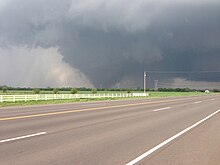
According to Köppen , the city is located in the humid subtropical climate zone (Cfa). This is in the form of the east side climate. The climate is humid all year round with a maximum of precipitation in June.
Long and hot summers are characteristic: The highest average temperature is 28 ° C in July, the daytime temperatures then reach an average of 34 ° C, but can also be significantly higher. On August 11, 1936, a heat record of 45 ° C was set. The winters only last a few months. Although temperatures are often mild, the occurrence of night frosts is not uncommon. During the day, however, temperatures almost always rise above freezing point. The coldest month is January with an average temperature of 4 ° C. The cold record comes from February 12, 1899, when the temperature was −27 ° C. The mean annual temperature in the period 1981-2010 was 16.4 ° C.
Since Oklahoma City is on Tornado Alley , there is an increased risk of tornadoes at certain times of the year . This is particularly great in the months of April to June, when the most and most violent storms occur. However, since records began in 1890 - with the exception of December and January - tornadoes have occurred every month of the year.
| Oklahoma City | ||||||||||||||||||||||||||||||||||||||||||||||||
|---|---|---|---|---|---|---|---|---|---|---|---|---|---|---|---|---|---|---|---|---|---|---|---|---|---|---|---|---|---|---|---|---|---|---|---|---|---|---|---|---|---|---|---|---|---|---|---|---|
| Climate diagram | ||||||||||||||||||||||||||||||||||||||||||||||||
| ||||||||||||||||||||||||||||||||||||||||||||||||
|
Average Monthly Temperatures and Rainfall for Oklahoma City 1981-2010
Source: National Weather Service
|
||||||||||||||||||||||||||||||||||||||||||||||||||||||||||||||||||||||||||||||||||||||||||||||||||||||||||||||||||||||||
politics

Oklahoma City is currently a stronghold of the Republican Party . The city has been ruled by a Republican without interruption since 1987. This fact can be attributed to the conservative electorate: According to a study from 2014, Oklahoma City ranks second in the list of the most conservative cities in the United States with at least 250,000 inhabitants.
Oklahoma City, the capital of the state of Oklahoma, is the seat of government and thus the location of the Oklahoma State Capitol . The Capitol combines the two chambers of the state legislature ( House of Representatives and Senate ). The city also acts as the seat of Oklahoma County and in that capacity is home to the Oklahoma County Courthouse . In congressional elections Oklahoma City is part of the constituency no. 5th
City administration
Since 1927 the city has had a Government Council Manager . By the citizens of Oklahoma City's are Mayor ( Mayor ) and the eight-member City Council ( City Council ) selected. Each member of the city council represents one of the eight constituencies ( wards ). The mayor's term of office is four years; that of the city council two. They appoint a full-time City Manager ( City Manager ), which transposes the provisions of the City Council.
Republican Mick Cornett has held the position of mayor since 2004 . After the election in March 2014, when he received a 65.7% approval rating, he is ruling in his fourth term.
Twin cities
Infrastructure
traffic



The main means of transport is the car, with which around 94% of the population commute to work. Public transport, on the other hand, only plays a limited role: only 0.7% (as of 2013) of employees use it on their way to work (excluding taxis).
Road network
Oklahoma City is well connected to the US highway network. Three interstate highways run through the city . The Interstate 35 connects the city to Wichita , Kansas City and Minneapolis in the north, as well as Dallas , Fort Worth , Austin and San Antonio in the south. The Interstate 40 provides connections to Amarillo and Albuquerque in the West, and Little Rock , Memphis , Nashville and Knoxville in the east. The Interstate 44 provides connections to Wichita Falls to the southwest and Tulsa , Springfield and St. Louis in the northeast.
In addition, the world-famous Route 66 runs through the city.
air traffic
Nearby are Will Rogers World Airport and the smaller Wiley Post Airport , which is currently under construction. The airports are named after two people who were killed in the same plane crash in Alaska . Will Rogers World Airport is Oklahoma's most important civil airport with 12,000 travelers daily (as of 2014) and flies to the largest cities in the United States, including New York City , Los Angeles , Chicago , Houston and Phoenix .
Public transportation
At the Santa Fe Depot which runs twice daily Heartland Flyer train company Amtrak to Fort Worth , Texas from. There are connections to Dallas, Chicago and San Antonio.
The bus company Embark has set up a network of routes within the urban area that extends from the hub in the center of downtown to the suburbs. Of the total of 19 lines, 16 run from Monday to Saturday and 3 only on weekdays.
In September 2013, the city council passed the resolution to reintroduce a tram . In the first construction phase, a rail network of around seven kilometers is to be created. Construction began on February 7, 2017. In the meantime, further expansion plans have been approved and connections to the ferry traffic are planned.
The Oklahoma City tram opened on December 14, 2018.
Ferry traffic
The Oklahoma River is operated by ferries from April to December .
Water supply
In the 1910s, the planning of the first reservoir to supply water to the population began. Lake Overholser was completed in 1918 . Construction on Lake Hefner was interrupted during World War II and completed in 1947. 15 years later the Lake Stanley Draper followed . These three lakes, which are located in the urban area, are still important today for water distribution. In the early 1960s, the city built a lake 160 kilometers away and piped the water to Oklahoma City. In 1983, Sardis Lake , another reservoir was completed, which is outside the city.
education
There are several colleges in Oklahoma City. The largest college in the city and one of the largest in the state is Oklahoma City Community College , which has 22,000 students.
With a student population of 7,000, Oklahoma State University – Oklahoma City is the largest university in the city. There is also Oklahoma City University , with a total of 4,000 students, and Oklahoma Christian University with 2,000 students.
There are also several branch offices of other large state universities in the city. The University of Central Oklahoma Music Academy is located downtown and the University of Oklahoma Medical Faculty , whose main campus is in nearby Norman, is also nearby .
economy
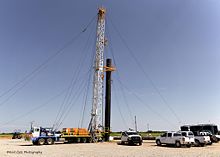
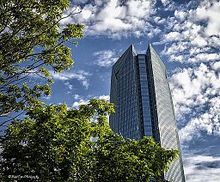
The city of Oklahoma City is currently considered a particularly strong industrial location. For years, the economy Oklahoma City's enjoying rapid growth , which was in each case more than four percent in 2011 and 2012 and it was 3.9% a year. The unemployment rate , which is 3.9% according to the American Community Survey , is one of the lowest in the US. The trend has been declining for years.
The median income of an employee is slightly below average US $ 28,000 per year. According to the US Department of Labor, the average hourly wage in the Oklahoma City metropolitan area is $ 20.47 (as of 2013). This value is 8% below the national average.
The main employers in the greater Oklahoma City area are (as of July 2014) the State of Oklahoma (42,000 jobs), Tinker Air Force Base (27,000) and the University of Oklahoma (11,900).
The metropolitan area of Oklahoma City generated an economic output of 65.7 billion US dollars in 2016. A large part of the economic activity of the state of Oklahoma is generated in the metropolitan area.
Industry
Oklahoma City is located directly above an oil field , which is why the production of oil and natural gas has played a key role since the 1930s. In total there are around 1,400 oil and gas wells within the city limits (as of 2014), of which around 1,100 are active. They are mostly on private property. The city earns US $ 3.7 million annually through licensing (average from 2004 to 2014). The petroleum companies Devon Energy and Chesapeake Energy , which are among the largest natural gas producers in the United States, were among the 500 companies with the highest sales in the world in 2014 . Then there is OGE Energy , which is listed in the Top 1000. Experts and politicians are critical of the city's excessive dependence on the energy industry. The mayor also admitted this problem.
In addition, the automotive industry was represented in the city for almost 30 years with a General Motors production facility . The factory employed up to 5,000 workers at its peak. As part of a realignment, the plant was temporarily closed in 2001. From 2002 only off-road sedans were produced. In November 2005, the group announced that the production facility would be closed for the beginning of the following year. More than 2,000 jobs were lost in the process.
Agriculture
Livestock is one of the most traditional branches of industry in the region. The Oklahoma National Stock Yards Company began operations in October 1910. To the cattle markets of the city is particularly with cattle traded. The auctions, which still take place regularly today, are open to visitors.
Established businesses
- OGE Energy , electricity company
- Devon Energy , energy company
- Love's Travel Stops & Country Stores , gas station operators
- Taco Mayo , franchise system catering chain
- Chesapeake Energy , oil and gas producer
- SandRidge Energy , oil and gas producer
Culture and sights
Museums
Some of the city's premier museums include the Science Museum Oklahoma , the Oklahoma City National Memorial Museum , the National Cowboy & Western Heritage Museum , the Sam Noble Oklahoma Museum of Natural History, and the Museum of Osteology .
Sports
Team sport
The city's flagship is the Oklahoma City Thunder basketball team , which plays in the NBA . It plays its home games in the Chesapeake Energy Arena . The Oklahoma City Barons are the city's best-known ice hockey team and take part in the American Hockey League . Your games will take place at the Cox Convention Center . The Oklahoma City Dodgers play minor league baseball . Their home games are played at the Chickasaw Bricktown Ballpark . In professional football, the city is represented by the Oklahoma City Energy franchise , which plays in the USL Professional Division . The club plays its games at the Pribil Stadium.
Other sports
Equestrian sport is also popular here . The city describes itself as the world capital of horse shows ("Horse Show Capital of the World"). The American Quarter Horse Association World Championship takes place in Oklahoma City every November . The Oklahoma State Fair Arena is the venue for most competitions . The Oklahoma River is the official training ground of the Olympic and Paralympic rowing and canoeing teams in the USA and the venue for important competitions in these sports.
media
With the conservative daily newspaper The Oklahoman , the largest print medium in the state is based in Oklahoma City. In terms of daily circulation , it ranks 58th among the largest daily newspapers in Germany with around 125,000 copies (as of June 2013).
All major television networks have local branches in Oklahoma City :
- NBC : KFOR-TV (Channel 4)
- ABC : KOCO-TV (Channel 5)
- CBS : KWTV-DT (Channel 9)
- PBS : KETA-TV (Channel 13)
- FOX : KOKH-TV (Channel 25)
- CW : KOCB (Channel 34)
- MyNetworkTV : KSBI (Channel 52)
freetime and recreation
The Bricktown Canal, completed in 1999, is a tourist attraction. Round trips are offered in water taxis .
The public Oklahoma City Zoo has up to one million visitors annually. It is the habitat of 500 species and was opened as a small menagerie back in 1902 .
Frontier City amusement park is western-themed and is located just off Interstate 35. It features roller coasters, a Ferris wheel, live shows, and concerts, among other things.
National Park Service
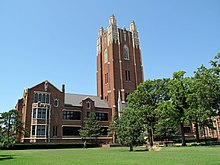
The National Park Service has 107 buildings and sites in the city on the National Register of Historic Places (NRHP) (as of November 10, 2018).
City personalities
Web links
- City of Oklahoma City (English)
- Tourism website of Oklahoma City (English)
- Information in German
Individual evidence
- ^ Oklahoma City History. In: visitokc.com. Oklahoma City Convention & Visitors Bureau, accessed January 28, 2015 .
- ↑ a b c Linda D. Wilson: Oklahoma City. In: Encyclopedia of Oklahoma History and Culture. Oklahoma Historical Society, accessed December 12, 2014 .
- ↑ Previous Mayors. (No longer available online.) In: okc.gov. City of Oklahoma City, archived from the original on September 28, 2007 ; accessed on December 12, 2014 . Info: The archive link was inserted automatically and has not yet been checked. Please check the original and archive link according to the instructions and then remove this notice.
- ↑ a b c d Vivien Lou Chen: Oklahoma City Penn Square Lessons Give It 5.6% Jobless Rate. In: bloomberg.com. Bloomberg LP , April 15, 2009, accessed January 29, 2015 .
- ^ A b c Keaton Fox: Oklahoma's economy looks similar to 1980's prior to bust. In: okcfox.com. WorldNow and KOKH, November 7, 2014, accessed January 28, 2015 .
- ↑ a b c Kristina Shervory: A Downtown Becomes Full of Life Again. In: The New York Times . The New York Times Company , January 26, 2010, accessed December 18, 2014 .
- ↑ MAPS. (No longer available online.) In: okc.gov. City of Oklahoma City, archived from the original on February 21, 2015 ; accessed on January 30, 2015 (English). Info: The archive link was inserted automatically and has not yet been checked. Please check the original and archive link according to the instructions and then remove this notice.
- ↑ Alex Cameron: Saturday Marks 20 Years Since OKC Voters Approved MAPS. In: news9.com. WorldNow and KWTV, December 14, 2013, accessed January 30, 2015 .
- ^ Derek Thompson: Why Oklahoma City Could Represent the Future of America. In: theatlantic.com . The Atlantic Monthly Group, September 13, 2010, accessed January 30, 2015 .
- ↑ Joshua Zumbrun: America's Recession-Proof Cities. In: forbes.com . Forbes Inc., April 29, 2008, accessed January 24, 2015 .
- ^ Census of Population and Housing. In: census.gov. United States Census Bureau , accessed December 5, 2014 .
- ^ A b c Oklahoma City (city), Oklahoma. (No longer available online.) In: quickfacts.census.gov. United States Census Bureau, archived from the original on March 28, 2009 ; accessed on January 24, 2015 . Info: The archive link was inserted automatically and has not yet been checked. Please check the original and archive link according to the instructions and then remove this notice.
- ↑ a b 2010 Demographic Profile Data. In: factfinder2.census.gov. United States Census Bureau, accessed January 27, 2015 .
- ↑ Les Christie: 10 fastest growing cities. In: money.cnn.com . Turner Broadcasting System , March 27, 2014, accessed January 24, 2015 .
- ^ Sara Schwartzkopf: Top 5 Cities With The Most Native Americans. In: indiancountrytodaymedianetwork.com. July 29, 2013, accessed January 24, 2015 .
- ↑ 2009–2013 American Community Survey 5-Year Estimates. In: factfinder2.census.gov. United States Census Bureau, accessed January 26, 2015 .
- ^ Crime rate in Oklahoma City, Oklahoma (OK). In: City Data . Advameg, Inc., accessed December 5, 2014 .
- ↑ City Crime Rankings 2014. (PDF) In: cqpress.com . SAGE Publications , accessed November 27, 2014 .
- ^ Frontier Country. In: travelok.com. Oklahoma Tourism & Recreation Department, accessed December 8, 2014 .
- ^ Oklahoma City, Oklahoma Map. (PDF) (No longer available online.) In: okc.gov. City of Oklahoma City, p. 35 , archived from the original on December 16, 2014 ; accessed on December 10, 2014 . Info: The archive link was inserted automatically and has not yet been checked. Please check the original and archive link according to the instructions and then remove this notice.
- ^ Oklahoma River. (No longer available online.) In: okc.gov. City of Oklahoma City, archived from the original on March 5, 2015 ; accessed on December 8, 2014 . Info: The archive link was inserted automatically and has not yet been checked. Please check the original and archive link according to the instructions and then remove this notice.
- ^ Ward Map. (No longer available online.) In: okc.gov. City of Oklahoma City, archived from the original on December 18, 2014 ; accessed on December 18, 2014 . Info: The archive link was inserted automatically and has not yet been checked. Please check the original and archive link according to the instructions and then remove this notice.
- ^ Comprehensive Plan Amendment Map. (No longer available online.) In: okc.gov. City of Oklahoma City, archived from the original on March 5, 2016 ; accessed on December 18, 2014 . Info: The archive link was inserted automatically and has not yet been checked. Please check the original and archive link according to the instructions and then remove this notice.
- ^ A b c Oklahoma City, Oklahoma. In: weatherbase.com. CantyMedia, accessed December 25, 2014 .
- ^ A b Oklahoma City: Geography and Climate. In: City Data. Advameg, Inc., accessed December 5, 2014 .
- ↑ a b Threaded Climate Extremes for Oklahoma City Area, OK. (No longer available online.) In: threadex.rcc-acis.org. ThreadEx, archived from the original on June 27, 2014 ; accessed on January 24, 2015 . Info: The archive link was inserted automatically and has not yet been checked. Please check the original and archive link according to the instructions and then remove this notice.
- ^ Tornadoes in the Immediate OKC Area by Month. In: srh.noaa.gov. National Weather Service , accessed January 26, 2015 .
- ↑ Urban development. In: economist.com . The Economist Group , August 1, 2014, accessed November 27, 2014 .
- ^ Ward Map. (No longer available online.) In: okc.gov. City of Oklahoma City, archived from the original on March 1, 2015 ; accessed on December 7, 2014 (English). Info: The archive link was inserted automatically and has not yet been checked. Please check the original and archive link according to the instructions and then remove this notice.
- ^ Mayor & Council. (No longer available online.) In: okc.gov. City of Oklahoma City, archived from the original on February 1, 2015 ; accessed on December 7, 2014 (English). Info: The archive link was inserted automatically and has not yet been checked. Please check the original and archive link according to the instructions and then remove this notice.
- ^ City of Oklahoma City Elections. (No longer available online.) In: okc.gov. City of Oklahoma City, archived from the original on December 14, 2014 ; accessed on December 7, 2014 (English). Info: The archive link was inserted automatically and has not yet been checked. Please check the original and archive link according to the instructions and then remove this notice.
- ^ William Crum: Oklahoma City's Mick Cornett wins fourth term as mayor. In: NewsOK.com . Oklahoma Publishing Company , March 4, 2014, accessed November 27, 2014 .
- ↑ a b c 2013 American Community Survey 1-Year Estimates. In: factfinder.census.go. United States Census Bureau, accessed December 10, 2014 .
- ^ William Crum: Oklahoma City unveils plans for $ 70 million expansion at Will Rogers World Airport. In: NewsOK.com. Oklahoma Publishing Company, March 5, 2014, accessed December 6, 2014 .
- ↑ Heartland Flyer. In: deutsch.amtrak.com. National Railroad Passenger Corporation, accessed December 15, 2014 .
- ↑ EMBARK SystemMap. (PDF) In: embarkok.com. Central Oklahoma Transportation and Parking Authority, accessed December 9, 2014 .
- ^ William Crum: Oklahoma City Council gives streetcar route the go-ahead. In: NewsOK.com. Oklahoma Publishing Company, September 24, 2013, accessed December 15, 2014 .
- ↑ Bernhard Kussmagk: Return after 72 years as a "zigzag ring". In: Straßenbahn Magazin , 6/2019, pp. 44–46.
- ^ Oklahoma River Cruises. (No longer available online.) In: visitokc.com. Oklahoma City Convention & Visitors Bureau, archived from the original on December 10, 2014 ; accessed on December 10, 2014 . Info: The archive link was inserted automatically and has not yet been checked. Please check the original and archive link according to the instructions and then remove this notice.
- ^ Oklahoma City's water history. (No longer available online.) In: okc.gov. City of Oklahoma City, archived from the original on April 26, 2015 ; accessed on December 15, 2014 . Info: The archive link was inserted automatically and has not yet been checked. Please check the original and archive link according to the instructions and then remove this notice.
- ↑ Official website of Oklahoma City Community College (English)
- ↑ Oklahoma State University – Oklahoma City at usnews.com (English)
- ↑ http://www.okcu.edu/about/
- ↑ Oklahoma Christian University at LinkedIn (English)
- ↑ Official website of the University of Central Oklahoma (English)
- ↑ Official website of the University of Oklahoma (English)
- ↑ Paul Monies: Oklahoma City, Tulsa metro economic growth paces jump ahead of national average. In: NewsOK.com. Oklahoma Publishing Company, September 17, 2014, accessed December 30, 2014 .
- ^ A b Brianna Bailey: Oklahoma City continues to have one of lowest unemployment rates in the nation. In: NewsOK.com. Oklahoma Publishing Company, December 9, 2014, accessed December 23, 2014 .
- ^ Oklahoma City Area Economic Summary. In: bls.gov. Bureau of Labor Statistics , accessed December 23, 2014 .
- ^ Occupational Employment and Wages in Oklahoma City, May 2013. In: bls.gov. Bureau of Labor Statistics , accessed December 23, 2014 .
- ^ Oklahoma City MSA Major Employer List. In: greateroklahomacity.com. Greater Oklahoma City Chamber, accessed January 31, 2015 .
- ^ US Department of Commerce, BEA, Bureau of Economic Analysis: Bureau of Economic Analysis. Retrieved July 4, 2018 (American English).
- ↑ Paul Monies: Oklahoma City residents express concerns about oil drilling plan for Lake Hefner. In: NewsOK.com. Oklahoma Publishing Company, December 18, 2014, accessed December 19, 2014 .
- ^ Bobby Weaver: General Motors Assembly Plant. In: Encyclopedia of Oklahoma History and Culture. Oklahoma Historical Society, accessed February 2, 2015 .
- ^ Lloyd Vries: GM Plan Leaves Workers In Shock. In: cbsnews.com. CBS Corporation , November 21, 2005, accessed February 2, 2015 .
- ↑ J'Nell L. Godfather: OKLAHOMA NATIONAL STOCKYARDS. In: Encyclopedia of Oklahoma History and Culture. Oklahoma Historical Society, accessed January 27, 2015 .
- ^ Horse Show Capital. In: okcchamber.com. Greater Oklahoma City Chamber , accessed December 8, 2014 .
- ↑ UNITED STATES OLYMPIC TRAINING SITE. (PDF) (No longer available online.) In: okc.gov. City of Oklahoma City, formerly in the original ; accessed on January 24, 2015 . ( Page no longer available , search in web archives ) Info: The link was automatically marked as defective. Please check the link according to the instructions and then remove this notice.
- ^ Telling our story. (No longer available online.) In: okc.gov. City of Oklahoma City, p. 4 , archived from the original on Jan. 22, 2015 ; accessed on January 24, 2015 . Info: The archive link was inserted automatically and has not yet been checked. Please check the original and archive link according to the instructions and then remove this notice.
- ↑ Top Media June 2013. burrellesluce.com, p. 1 , accessed on February 4, 2015 (English).
- ^ Facts about the Oklahoma City Zoological Park and Botanical Garden. (No longer available online.) In: okczoo.com. Oklahoma City Zoo, archived from the original on December 23, 2014 ; accessed on December 23, 2014 (English). Info: The archive link was inserted automatically and has not yet been checked. Please check the original and archive link according to the instructions and then remove this notice.
- ^ Frontier City Theme Park. In: travelok.com. Oklahoma Tourism & Recreation Department, accessed December 30, 2014 .
- ↑ Search mask database in the National Register Information System. National Park Service , accessed November 10, 2018.
